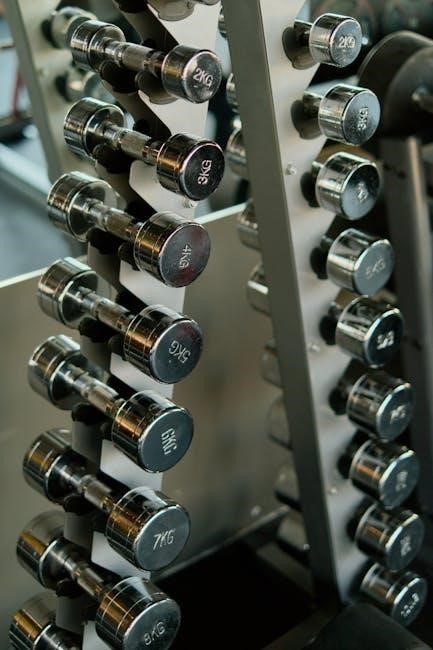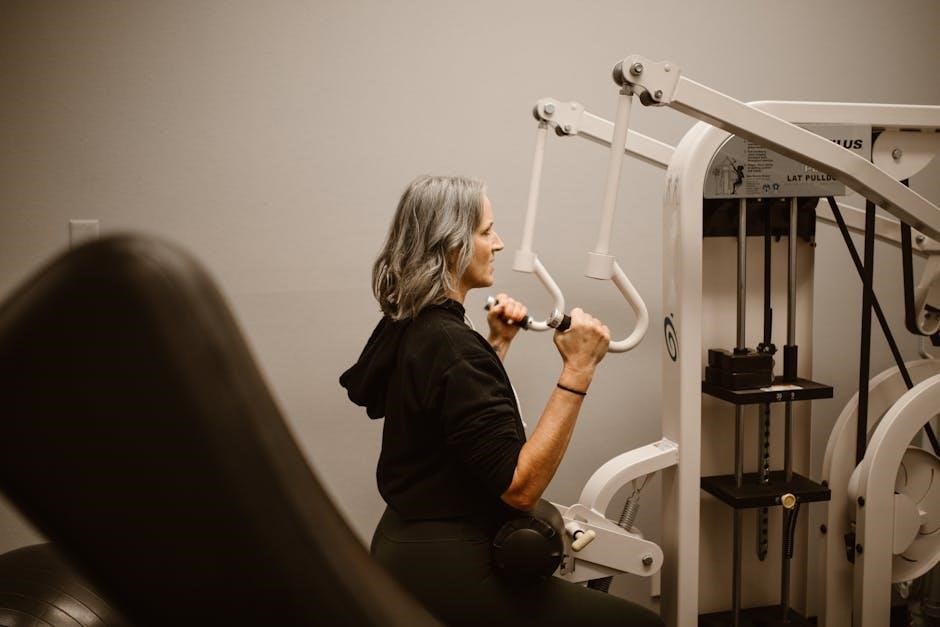Strength training is essential for individuals over 50 to maintain muscle mass, bone density, and overall health. It boosts metabolism and reduces injury risk, making aging active and vibrant. Starting early ensures long-term benefits, proving it’s never too late to build strength and confidence.
1.1 Importance of Strength Training for Aging Adults
Strength training is crucial for maintaining physical health as adults age. It helps combat muscle and bone loss, boosts metabolism, and enhances overall longevity. Regular strength exercises reduce the risk of falls and fractures, while improving mobility and energy levels. By incorporating strength training, older adults can maintain independence, perform daily tasks with ease, and enjoy a higher quality of life. It’s a proven method to stay active, healthy, and vibrant, addressing key concerns associated with aging. Consistency in strength training fosters resilience and supports long-term wellness, making it an essential part of a healthy lifestyle for adults over 50.
1.2 Benefits of Starting a Strength Program After 50
Starting a strength program after 50 offers numerous benefits, including increased muscle mass, improved bone density, and enhanced metabolic rate. It reduces the risk of chronic diseases, such as diabetes and heart conditions, while boosting energy levels. Strength training also improves mental health by reducing stress and anxiety, promoting better sleep and overall well-being. Additionally, it increases flexibility and balance, lowering the risk of falls and injuries. Engaging in strength exercises can help individuals maintain their independence and perform daily activities with greater ease. These benefits contribute to a healthier, more active lifestyle, making strength training an invaluable investment for aging adults.

Key Exercises for Women Over 50
Key exercises for women over 50 include squats, lunges, and planks, which improve posture, balance, and overall strength. These movements target major muscle groups effectively, promoting longevity and vitality.
2.1 Top 10 Strength Training Exercises for Women
The top 10 strength training exercises for women over 50 include squats, lunges, planks, push-ups, deadlifts, leg presses, chest presses, rows, and core exercises like Russian twists. These movements are essential for building muscle, improving posture, and enhancing overall strength. Squats and lunges target the lower body, while push-ups and chest presses focus on the upper body. Deadlifts and rows improve back strength, and planks build core stability. Incorporating these exercises into a routine helps women maintain independence, boost metabolism, and reduce the risk of injuries. They are versatile and can be done with or without weights, making them ideal for home workouts or gym sessions.
2.2 Focus on Lower Body Strength
Lower body strength is crucial for women over 50, as it enhances mobility, prevents falls, and supports daily activities. Exercises like squats, lunges, and leg presses target the legs and hips, improving balance and power. These movements also promote bone density, reducing the risk of osteoporosis. Bodyweight exercises, such as step-ups and glute bridges, are effective and require minimal equipment. Incorporating these into a routine helps maintain independence and overall health. Proper form and progression are key to avoiding injury and maximizing benefits. Strengthening the lower body ensures long-term mobility and confidence, making it a cornerstone of any strength training program for women over 50.
2.3 Core and Flexibility Exercises
Core and flexibility exercises are vital for women over 50, improving posture, balance, and overall mobility. Planks, bird dogs, and pelvic tilts strengthen the core, while cat-cow stretches and seated forward bends enhance flexibility. These exercises also reduce stiffness and improve range of motion, making daily activities easier. Incorporating yoga or Pilates can further boost flexibility and stability. Strengthening the core enhances spinal support, reducing back pain, while flexibility exercises prevent muscle tightness and injury. Combining these with strength training creates a well-rounded fitness routine, ensuring women maintain independence and mobility as they age. Regular practice promotes a stronger, more agile body.

Considerations for Starting a Strength Program
Consulting a doctor is crucial before starting any strength program, especially for those with health concerns. Setting realistic goals ensures sustainable progress and injury prevention. Choosing the right equipment, whether at home or in a gym, is essential for safety and effectiveness. A well-structured plan tailored to individual needs helps achieve desired results and maintain motivation. Proper form and technique are vital to avoid injuries and maximize benefits. Starting slowly and gradually increasing intensity ensures a safe and successful journey into strength training for women over 50.
3.1 Consulting a Doctor Before Beginning
Consulting a doctor before starting a strength training program is crucial, especially for women over 50. A medical professional can assess health conditions, such as joint issues or chronic illnesses, and provide personalized advice. This step ensures safety and helps prevent potential injuries. Discussing medications, mobility limitations, and any concerns with a doctor allows for tailored recommendations. A doctor’s clearance is essential for creating a workout plan that suits individual needs and promotes long-term health. This precaution is vital for those with pre-existing conditions or concerns about starting a new exercise regimen. A doctor’s guidance ensures a safe and effective strength training journey.
3.2 Setting Realistic Goals and Expectations
Setting realistic goals is key to a successful strength training program for women over 50. It’s important to define achievable objectives based on current fitness levels and health status. Goals should be specific, measurable, and time-bound to track progress effectively. For example, aiming to perform 10 squats in a row or increasing protein intake can be motivating milestones. Celebrating small victories helps maintain enthusiasm and commitment. Unrealistic expectations may lead to frustration, so aligning goals with personal capabilities ensures sustained effort and enjoyment. Regularly reassessing and adjusting goals keeps the program engaging and tailored to individual progress.
3.3 Choosing the Right Equipment
Choosing the right equipment for a strength training program over 50 is crucial for safety and effectiveness. Resistance bands, dumbbells, and medicine balls are excellent options for beginners, offering versatility and ease of use. Adjustable equipment allows for progressive overload, while bodyweight exercises provide a no-equipment alternative. Invest in a good pair of sneakers for support and consider a workout mat for comfort. When selecting weights, start light and gradually increase intensity. Consult a doctor or trainer to ensure equipment choices align with your fitness level and goals, promoting a safe and enjoyable workout experience tailored to your needs.

Sample Workout Plans for Over 50
Sample workout plans for over 50 are designed to enhance strength and flexibility, ensuring safety and effectiveness for long-term health benefits and fitness goals.
4.1 Full-Body Workouts Without Equipment
Full-body workouts without equipment are ideal for over 50s, focusing on bodyweight exercises like squats, push-ups, and lunges. These routines can be done anywhere, promoting strength, flexibility, and balance. They target both upper and lower body muscles, enhancing overall fitness. Perfect for home workouts, they require minimal space and no investment in gear. Regular practice improves muscle tone and boosts metabolism, aiding in weight management. These exercises are low-impact, reducing joint strain, making them suitable for aging adults. Consistency is key to achieving long-term health benefits and maintaining an active lifestyle.
4.2 Weekly Workout Schedules
A well-structured weekly workout schedule is crucial for consistency and progress. Many programs recommend dividing workouts into upper body, lower body, and core-focused days. For example, Monday and Thursday could focus on strength training, while Tuesday and Friday could emphasize flexibility and mobility. Wednesdays and weekends might be reserved for rest or light activity. This approach ensures a balanced routine without overexertion. Incorporating bodyweight exercises like squats, push-ups, and lunges can be effective. Schedules should also include warm-up routines and cool-down stretches to prevent injury. Staying consistent with a weekly plan helps build muscle and improves overall health, making it easier to stick to long-term fitness goals.
4.3 Progressive Overload for Muscle Growth
Progressive overload is a key principle for muscle growth, involving gradual increases in weight, resistance, or reps. For those over 50, this can be achieved with weights, resistance bands, or even bodyweight exercises. Starting with manageable loads and slowly increasing intensity ensures muscle engagement without risk of injury. For example, adding a pound each week or performing an extra rep each session can stimulate growth. Consistency is vital, as muscles adapt over time. This method helps maintain muscle mass, boosting metabolism and overall strength. Tracking progress in a workbook or app can motivate and guide the process effectively, ensuring continued improvement and health benefits. Proper form and recovery are essential to avoid setbacks.

Supplements and Nutrition
Supplements and nutrition play a vital role in strength training for over 50s. Creatine boosts muscle strength, while protein supports muscle repair. A balanced diet with vitamin D and calcium is essential for bone health and injury prevention.
5.1 Role of Creatine in Strength Training
Creatine is a powerful supplement for strength training, particularly beneficial for women over 50. It increases muscle strength, endurance, and power by enhancing energy production during intense efforts. Research shows creatine improves muscle function and supports bone health, reducing the risk of osteoporosis. It works by replenishing ATP stores, delaying fatigue, and promoting faster recovery. For women over 50, creatine is safe and effective, with studies indicating improved muscle mass and physical performance. A typical dose is 3-5 grams daily, mixed with water. Consistency yields results, making it a valuable addition to a strength training program. Always consult a healthcare provider before starting any supplement.
5.2 Importance of Protein Intake
Protein is crucial for muscle repair, growth, and maintenance, especially for women over 50 engaging in strength training. Adequate protein intake helps preserve muscle mass, which naturally declines with age. The recommended daily intake is 1.2-1.6 grams of protein per kilogram of body weight. Sources like lean meats, fish, eggs, legumes, and dairy are ideal. Protein supports recovery after workouts, reduces muscle soreness, and promotes overall health. Incorporating protein-rich meals or supplements, such as protein shakes, can enhance the effectiveness of a strength training program. Consistency in protein intake is key to achieving and maintaining strength gains, particularly as part of a structured fitness routine for women over 50.

Tracking Progress and Staying Motivated
Tracking progress through a workbook and celebrating milestones helps stay motivated. Seeing improvements encourages consistency, reinforcing the benefits of strength training over 50.
6.1 Using a 12-Week Workbook
A 12-week workbook is a powerful tool for tracking progress in strength training. It allows users to record workouts, set goals, and celebrate achievements. By documenting exercises, weights, and reps, individuals can monitor improvements and stay motivated. The workbook also helps identify plateaus, enabling adjustments to the training plan. Many programs include space for notes on nutrition, recovery, and how workouts feel physically and mentally. Progress photos and measurements can also be added to visualize changes. This structured approach ensures accountability and provides a clear path to success, making the journey of strength training over 50 organized and rewarding.
6.2 Celebrating Success and Staying Consistent
Celebrating success is crucial for maintaining motivation in a strength training program. Recognizing milestones, no matter how small, boosts confidence and encourages consistency. Whether it’s completing a challenging workout or noticing improved strength, acknowledging progress fosters a positive mindset. Sharing achievements with a support system or community can further enhance motivation. Consistency is key to long-term results, as muscle growth and strength improvements require regular effort. Staying committed involves setting a routine and adhering to it, even when progress feels slow. Over time, celebrating small wins and staying consistent leads to significant transformations, making the strength training journey rewarding and sustainable for women over 50.

Success Stories and Community Support
Inspirational stories from women over 50 who transformed their lives through strength training highlight the power of perseverance and community. Sharing journeys fosters motivation and accountability, creating a supportive network that celebrates every achievement, no matter how small, and encourages continued progress toward fitness goals.
7.1 Women Over 50 Who Found Strength
Many women over 50 have discovered newfound strength and confidence through tailored strength training programs. Their journeys often begin with simple exercises like squats or bodyweight movements, progressing to more advanced routines. These women inspire others by sharing their transformations, showcasing improved bone density, muscle growth, and enhanced overall health. Their stories highlight the empowerment that comes with taking control of physical fitness, proving that aging does not limit potential. By celebrating milestones and supporting one another, they create a motivating community that encourages perseverance and growth. Their success stories are a testament to the transformative power of strength training, regardless of age.
7.2 Joining a Community for Motivation
Joining a supportive community is a powerful motivator for women over 50 engaging in strength training. Gyms and fitness groups create a sense of belonging, fostering accountability and encouragement. Many women find inspiration in shared goals and celebrate each other’s progress, creating a positive and uplifting environment. Online forums and local clubs also provide valuable resources and camaraderie, helping individuals stay consistent with their workouts. Being part of a community enhances commitment and joy, making the strength training journey more rewarding and sustainable. Surrounding yourself with like-minded individuals ensures that motivation remains high, leading to long-term success and a stronger, healthier lifestyle.